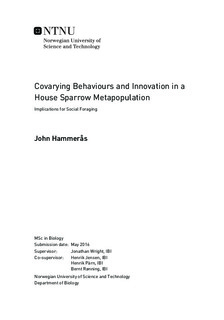Covarying Behaviours and Innovation in a House Sparrow Metapopulation - Implications for Social Foraging
Master thesis
Permanent lenke
http://hdl.handle.net/11250/2392923Utgivelsesdato
2016Metadata
Vis full innførselSamlinger
- Institutt for biologi [2512]
Sammendrag
Individuals in populations of many species have been found to differ consistently in suites of correlating behavioural measures. These phenomena appear to be heritable and subject to selection, thus making it as important to study the structure of behavioural correlations as it is to study each behaviour in isolation. In this part of a two-part study, flocks of house sparrows were observed at a communal feeder in captivity. We examined the individual variation and co-variance between the observed variables by the use of univariate models and hypothesis-testing with structural equation modelling (SEM). The model that fitted the data the best included correlations between variables thought to represent activity at the feeder. We also found repeatable individual differences in the specific use of the feeder, that is, individuals were found to visit the feeder for either many and short or few and long visits, suggesting alternative individual strategies for feeder use. One possible explanation for these findings in the use of the feeder is that they are expressions of true personality (i.e., consistent across contexts), while another is that they are a reflection of consistent social interactions within the flocks (e.g. dominance hierarchy). The second part of this two-part study examines the behaviour of the same individuals in a solitary context, and the combination of the two studies might distinguish between these possible explanations. Our results underline the importance of studying behaviours at the flock-level, and this points towards an interesting interplay between behavioural and population ecology in the future study of these phenomena.
